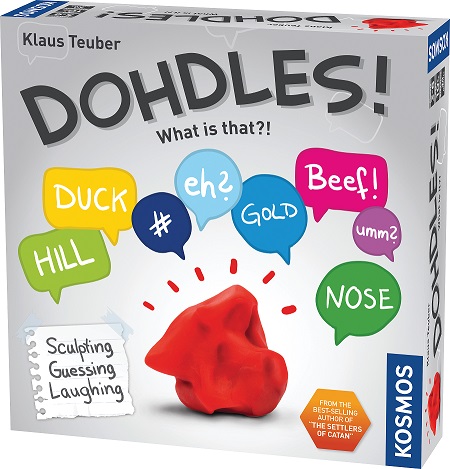 In Dohdles!, from Thames & Kosmos, the key is not getting things perfect to begin with. In this game that combines arts and crafts, guessing, and even a little bit of target practice, three to six players sculpt colorful dough into shapes, and other players must guess what the shape represents. To succeed, dough sculptures, or Dohdles, shouldn’t be instantly recognizable, but they also shouldn’t be too abstract, giving other players a chance to figure out the shape.
In Dohdles!, from Thames & Kosmos, the key is not getting things perfect to begin with. In this game that combines arts and crafts, guessing, and even a little bit of target practice, three to six players sculpt colorful dough into shapes, and other players must guess what the shape represents. To succeed, dough sculptures, or Dohdles, shouldn’t be instantly recognizable, but they also shouldn’t be too abstract, giving other players a chance to figure out the shape.
Dohdles! also features a game board, and the first to make it around to the finish line wins the game. To get things started, each player creates two Dohdles—or a trio, for games of three players—and places them on the board. Then, players take turns choosing which Dohdle on which they want to focus their attention.
The game has multiple moving parts, and here’s where they come into play: Each Dohdle’s spot on the board has a circumference around it, and whenever a player chooses that Dohdle, a colored chip moves along that path. Depending on where the chip lands, the player can either ask up to two questions about the nature of the sculpture, or request one of the letters (within the first five) of its name. Ideally, the Dohdle is difficult enough to warrant asking for a few hints, and that means points for the artist once a successful guess is made. But if too many hints are needed, the Dohdle-maker earns less or no points.
As far as guessing, at almost any time, other players can chime in if they believe they have deciphered the Dohdle. However, in order to do so, the guessing player must toss a colored cube through a chute at the center of the board while shouting, “Dohdle!” If their guess is right, their token moves closer to the finish line, while if they are mistaken, it moves backward. The chute works well in keeping multiple players from shouting answers across each other—even if more than one person tosses in a cube, whichever comes out first indicates who guesses.
In addition, there are rules governing when players can toss in their guessing cube, what happens if someone tosses it before a player can take their turn, etc. Considering that Dohdles! is both turn-based and something of a free-for-all, the rules do a good job of keeping things from ever getting out of hand. There’s also just the right amount of pressure to be a good modeling clay-based artist, since winning isn’t only reliant on being a great sculptor, but also by figuring out other players’ sculptures.
Speaking for myself, I managed to craft a ladle with just the right amount of mystery surrounding it, sparking questions like “Is the object man-made?” and “Could it be used to play sports?” But, I was terrible at keeping track of the clues for my opponents’ Dohdles. On the other hand, I enjoyed seeing other players’ interpretations of objects through their Dohdles, some of which were noticeably more successful than others. The bottom line: Some game-players are good at art, and some are good at reasoning, and it’s interesting to play a game such as Dohdles!, which calls upon—and helps develop—two very different skill sets like these.
While the game is definitely rule-based enough to warrant its age range, those patient enough to learn its ways will find Dohdles! an intriguing mix of imagination with feats of clay.
